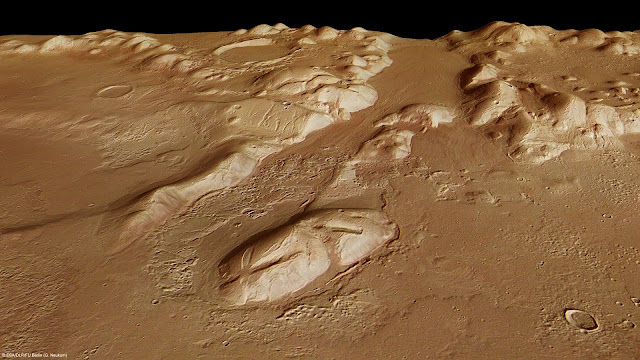Elysium Mons (13, 900m / 13, 9km - 46,000 ft / 8,6 mi)
MARS
Image from camera B (541A44, 541A46). Red filter used . Resolution is about 144 m/pixel.
The Mountain
Elysium Mons (13,900m / 13, 9km - 46,000 ft / 8,6 mi) is a volcano on Mars located in the volcanic province Elysium, at 25.02°N 147.21°E, in the Martian eastern hemisphere. It stands about above the surrounding lava plains, and about 16 km (52,000 ft) above the Martian datum. Its diameter is about 240 km (150 mi), with a summit caldera about 14 km (8.7 mi) across. It is flanked by the smaller volcanoes Hecates Tholus to the northeast, and Albor Tholus to the southeast.
A 6.5 km diameter crater at 29.674 N, 130.799 E, in the volcanic plains to the northwest of Elysium Mons has been identified as a possible source for the nakhlite meteorites, a family of similar basaltic Martian meteorites with cosmogenic ages of about 10.7 Ma, suggesting ejection from Mars by a single impact event. This implies that Martian volcanism had slowed greatly by that point in history.
The Mission
NASA Viking Orbiter 1 was the first of two spacecraft (along with Viking 2) sent to Mars as part of NASA's Viking program. On July 20, 1976, it became the second spacecraft to soft-land on Mars, and the first to successfully perform its mission. (The first spacecraft to soft-land on Mars was the Soviet Union's Mars 3 on December 2, 1971, which stopped transmitting after 14.5 seconds.) Viking 1 held the record for the longest Mars surface mission of 2307 days (over 61⁄4 years) or 2245 Martian solar days, until that record was broken by the Opportunity rover on May 19, 2010. Following launch using a Titan/Centaur launch vehicle on August 20, 1975, and an 11-month cruise to Mars, the orbiter began returning global images of Mars about 5 days before orbit insertion. The Viking 1 Orbiter was inserted into Mars orbit on June 19, 1976, and trimmed to a 1513 x 33,000 km, 24.66 h site certification orbit on June 21. Landing on Mars was planned for July 4, 1976, the United States Bicentennial, but imaging of the primary landing site showed it was too rough for a safe landing. The landing was delayed until a safer site was found, and took place instead on July 20, the seventh anniversary of the Apollo 11 Moon landing. The lander separated from the orbiter at 08:51 UTC and landed at Chryse Planitia at 11:53:06 UTC. It was the first attempt by the United States at landing on Mars.
The instruments of the orbiter consisted of two vidicon cameras for imaging (VIS), an infrared spectrometer for water vapor mapping (MAWD) and infrared radiometers for thermal mapping (IRTM). The orbiter primary mission ended at the beginning of solar conjunction on November 5, 1976.
The extended mission commenced on December 14, 1976, after solar conjunction. Operations included close approaches to Phobos in February 1977. The periapsis was reduced to 300 km on March 11, 1977. Minor orbit adjustments were done occasionally over the course of the mission, primarily to change the walk rate — the rate at which the areocentric longitude changed with each orbit, and the periapsis was raised to 357 km on July 20, 1979. On August 7, 1980, Viking 1 Orbiter was running low on attitude control gas and its orbit was raised from 357 × 33943 km to 320 × 56000 km to prevent impact with Mars and possible contamination until the year 2019. Operations were terminated on August 17, 1980, after 1485 orbits. A 2009 analysis concluded that, while the possibility that Viking 1 had impacted Mars could not be ruled out, it was most likely still in orbit. More than 57,000 images were sent back to Earth.
_____________________________
2021 - Wandering Vertexes...
by Francis Rousseau







